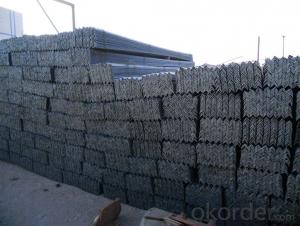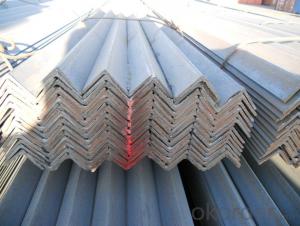Equal Steel Angle
- Loading Port:
- Tianjin Port China
- Payment Terms:
- TT or LC
- Min Order Qty:
- 25MT m.t.
- Supply Capability:
- 600000MT/YEAR m.t./month
OKorder Service Pledge
OKorder Financial Service
You Might Also Like
Specifications of Equal Steel Angle
1. Standards: GB,ASTM,BS,AISI,DIN,JIS
2. Length:6m,9m,12m
3. Material:Material: GB Q235B, Q345B or Equivalent; ASTM A36; EN 10025, S235JR, S355JR; JIS G3192,
SS400; SS540.
4. Sizes:
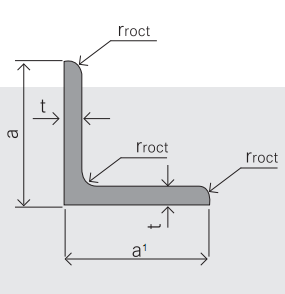
|
Sizes: 25mm-250mm | ||
|
a*t | ||
|
25*2.5-4.0 |
70*6.0-9.0 |
130*9.0-15 |
|
30*2.5-6.6 |
75*6.0-9.0 |
140*10-14 |
|
36*3.0-5.0 |
80*5.0-10 |
150*10-20 |
|
38*2.3-6.0 |
90*7.0-10 |
160*10-16 |
|
40*3.0-5.0 |
100*6.0-12 |
175*12-15 |
|
45*4.0-6.0 |
110*8.0-10 |
180*12-18 |
|
50*4.0-6.0 |
120*6.0-15 |
200*14-25 |
|
60*4.0-8.0 |
125*8.0-14 |
250*25 |
5. Material details:
|
Alloy No |
Grade |
Element (%) |
|||||
|
C |
Mn |
S |
P |
Si |
|||
|
|
|
|
|
|
|
|
|
|
Q235 |
B |
0.12—0.20 |
0.3—0.7 |
≤0.045 |
≤0.045 |
≤0.3 |
|
|
|
|
|
|
|
|
|
|
|
Alloy No |
Grade |
Yielding strength point( Mpa) |
|||||
|
Thickness (mm) |
|||||||
|
≤16 |
>16--40 |
>40--60 |
>60--100 |
||||
|
≥ |
|||||||
|
|
|
|
|
|
|
||
|
Q235 |
B |
235 |
225 |
215 |
205 |
||
|
Alloy No |
Grade |
Tensile strength (Mpa) |
Elongation after fracture (%) |
||||
|
Thickness (mm) |
|||||||
|
|
≤16 |
>16--40 |
>40--60 |
>60--100 |
|||
|
≥ |
|||||||
|
|
|
|
|
|
|
|
|
|
Q235 |
B |
375--500 |
26 |
25 |
24 |
23 |
|
Usage & Applications of Equal Steel Angle
Trusses;
Transmission towers;
Telecommunication towers;
Bracing for general structures;
Stiffeners in structural use.
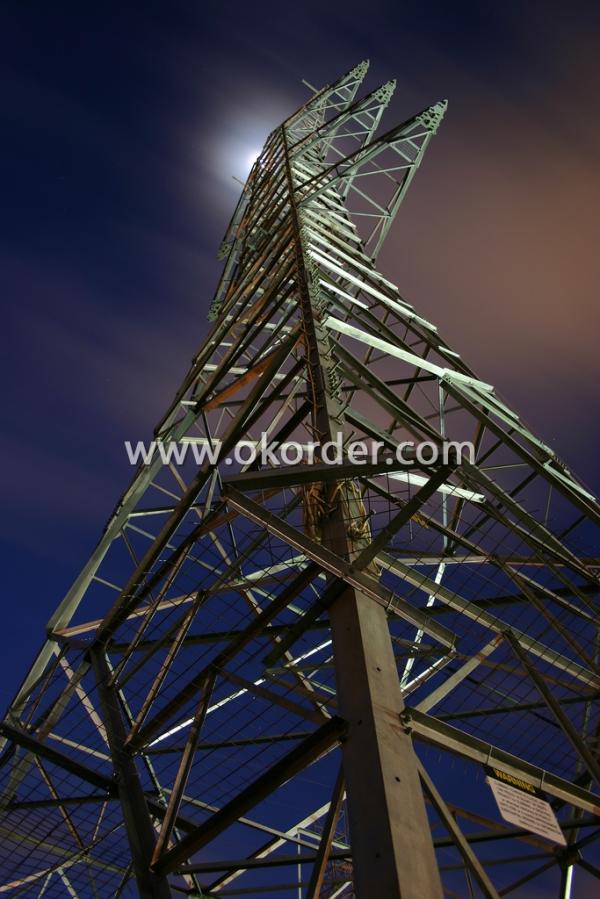
Packaging & Delivery of Equal Steel Angle
1.Transportation: the goods are delivered by truck from mill to loading port, the maximum quantity can be loaded is around 40MTs by each truck. If the order quantity cannot reach the full truck loaded, the transportation cost per ton will be little higher than full load.
2.With bundles and load in 20 feet/40 feet container, or by bulk cargo, also we could do as customer's request.
3. Marks:
Color mark: There will be color marking on both end of the bundle for the cargo delivered by bulk vessel. That makes it easily to distinguish at the destination port.
Tag mark: There will be tag mark tied up on the bundles. The information usually including supplier logo and name, product name, made in China, shipping marks and other information request by the customer.
If loading by container the marking is not needed, but we will prepare it as customer request.


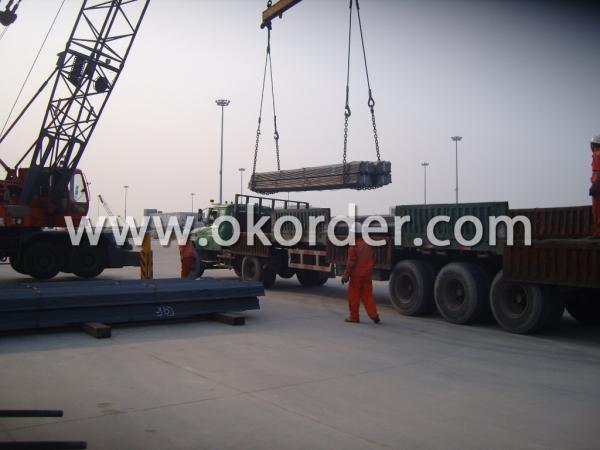
- Q:How do steel angles differ from steel channels?
- Steel angles and steel channels differ in their structural shape. Steel angles have an L-shaped cross-section, consisting of two legs that are perpendicular to each other. On the other hand, steel channels have a U-shaped cross-section, with a flat bottom and two flanges on the sides. These different shapes make steel angles suitable for providing structural support and stability in various applications, while steel channels are often used for framing and reinforcement purposes.
- Q:What are the different methods for fastening steel angles?
- Fastening steel angles can be done in several ways, depending on the specific application and load requirements. Some commonly used methods include the following: 1. Bolting: Bolting is a popular method for securing steel angles. It involves using bolts, washers, and nuts to attach the angle to a structure or another piece of steel. This method provides a strong and dependable connection, especially when the bolts are tightened to the correct torque specification. 2. Welding: Welding is another commonly employed technique for fastening steel angles, particularly when a permanent and sturdy connection is necessary. It entails melting the base metal and the angle together to form a robust joint. Various welding techniques, such as arc welding, MIG welding, or TIG welding, can be utilized. 3. Riveting: Riveting is a method that involves using rivets to join steel angles together or to other components. This approach creates a secure and durable connection, especially in situations where there may be vibration or movement. Riveting requires drilling holes in the steel angles and using a rivet gun to insert the rivets through the holes. 4. Adhesive bonding: Adhesive bonding can be employed in certain applications to fasten steel angles. This method involves applying a high-strength adhesive or epoxy between the angle and the surface to which it is being attached. Adhesive bonding offers a clean and visually appealing connection while also evenly distributing loads across the joint. 5. Clamping: Clamping is a temporary method used to hold steel angles in place during assembly or construction. It involves using clamps or brackets until a more permanent fastening method, such as bolting or welding, can be applied. Each method has its own advantages and disadvantages, and the choice depends on factors such as load requirements, structural design, cost, and the need for disassembly or adjustability. Selecting the appropriate fastening method is crucial to ensure the safety and integrity of the steel angles in their intended application.
- Q:Can steel angles be used for door frames?
- Indeed, door frames can utilize steel angles. These angles are frequently employed in the construction industry due to their robustness and endurance. They furnish a firm and steady foundation for the door frame, guaranteeing its steadfastness and durability. Moreover, steel angles can be effortlessly tailored and trimmed to suit the specified dimensions of the door frame. They also possess resistance to distortion, decay, and termite infestation, rendering them an excellent selection for door frames. In conclusion, steel angles present a dependable and utilitarian approach to constructing door frames.
- Q:How do you prevent galvanic corrosion between steel angles and aluminum components?
- To avoid galvanic corrosion between steel angles and aluminum components, there are multiple actions you can take: 1. Implement a barrier: Employ a non-conductive coating or a layer of paint to create a physical barrier between the steel and aluminum surfaces. This will obstruct direct contact between the two metals, decreasing the chances of galvanic corrosion. 2. Use insulating tape or gaskets: Position insulating tape or gaskets made of non-conductive materials, like rubber or plastic, between the steel angles and aluminum components. This will act as a buffer, preventing direct contact and reducing the risk of galvanic corrosion. 3. Select compatible metals: Opt for metals that are more compatible with each other when designing or selecting components. For example, consider using stainless steel or galvanized steel instead of regular steel when paired with aluminum, as this can decrease the risk of galvanic corrosion. 4. Utilize isolation techniques: Isolate the steel angles and aluminum components using techniques like plastic or rubber spacers. These spacers separate the metals, preventing direct contact and minimizing the potential for galvanic corrosion. 5. Apply corrosion inhibitors: Apply special coatings or compounds to the steel and aluminum surfaces that act as corrosion inhibitors. These inhibitors create a protective layer, helping to prevent galvanic corrosion. 6. Control the environment: Galvanic corrosion is accelerated in the presence of moisture, saltwater, or acidic environments. Decrease the exposure of steel angles and aluminum components to these corrosive elements by ensuring proper ventilation, drainage, and maintaining suitable protective coatings. When selecting the most appropriate method or combination of methods to prevent galvanic corrosion between steel angles and aluminum components, it is crucial to carefully consider the specific requirements and conditions of your application. Seeking advice from corrosion experts or engineers can provide valuable insights and tailored guidance for your particular situation.
- Q:Can steel angles be used in telecommunications or broadcasting structures?
- Yes, steel angles can certainly be used in telecommunications or broadcasting structures. Steel angles provide structural support and stability, making them ideal for constructing towers, antennas, and other infrastructure required for telecommunications and broadcasting purposes.
- Q:What are the different welding methods used for steel angles?
- There are several different welding methods that can be used for steel angles. The choice of method depends on various factors including the thickness of the steel, the type of joint, and the desired outcome. Here are some of the commonly used welding methods for steel angles: 1. Shielded Metal Arc Welding (SMAW): Also known as stick welding, SMAW uses a consumable electrode coated in flux. The electrode is manually fed into the joint, and the flux creates a protective shield around the weld pool. SMAW is versatile and can be used for various joint configurations and thicknesses. 2. Gas Metal Arc Welding (GMAW): Commonly referred to as MIG (Metal Inert Gas) or MAG (Metal Active Gas) welding, GMAW uses a wire electrode that is continuously fed through a welding gun. The electrode melts and joins the steel angles together, while a shielding gas (either inert or active) protects the weld pool. GMAW is fast and suitable for thin to medium thickness steel angles. 3. Flux-Cored Arc Welding (FCAW): Similar to GMAW, FCAW uses a continuously fed wire electrode. However, the electrode is filled with flux, eliminating the need for an external shielding gas. FCAW is versatile, easy to use, and can be employed in various positions. It is commonly used for thicker steel angles and in outdoor applications where wind might affect gas shielding. 4. Gas Tungsten Arc Welding (GTAW): Also known as TIG (Tungsten Inert Gas) welding, GTAW uses a non-consumable tungsten electrode to create an arc. A separate filler metal is manually added to the joint, while a shielding gas protects the weld pool. GTAW produces high-quality, precise welds and is commonly used for thinner steel angles or when aesthetics are important. 5. Submerged Arc Welding (SAW): This method involves feeding a continuously fed wire electrode into the joint while simultaneously covering the weld area with a layer of granular flux. The flux acts as a protective medium and prevents atmospheric contamination. SAW is commonly used for thicker steel angles and in applications where high deposition rates are required. These are just a few of the welding methods commonly used for steel angles. Each method has its advantages and limitations, and the choice of method should be based on the specific requirements of the project. It is important to consult with a qualified welding professional to determine the most suitable method for a particular application.
- Q:How do you calculate the deflection of a steel angle?
- To calculate the deflection of a steel angle, you would need to consider several factors and apply the appropriate formulas. The deflection of a beam or angle is typically calculated using the Euler-Bernoulli beam theory, which assumes that the beam is slender and experiences small deflections. First, you need to determine the moment of inertia (I) of the steel angle. This can be calculated using the dimensions and properties of the angle section. The moment of inertia represents the resistance of the angle to bending. Next, you should determine the applied load or force (F) acting on the steel angle. This could be a concentrated load, distributed load, or a combination of both. The load will cause a bending moment (M) on the angle. Once you have determined the moment of inertia and the bending moment, you can use the formula for deflection in a simply supported beam: δ = (5 * M * L^4) / (384 * E * I) Where: - δ is the deflection at the midpoint of the steel angle - M is the bending moment acting on the angle - L is the length of the angle - E is the modulus of elasticity of the steel material - I is the moment of inertia of the angle section By plugging in the appropriate values into the formula, you can calculate the deflection. It is important to ensure that the units are consistent and compatible when performing the calculations. However, note that this calculation assumes linear behavior and neglects factors such as shear deformation and lateral torsional buckling. For more accurate results, you may need to consider additional factors or consult engineering resources, such as design codes or software, to obtain a more precise deflection calculation.
- Q:Can steel angles be used for railings or barriers?
- Absolutely, railings or barriers can indeed utilize steel angles. In construction, steel angles are widely employed and renowned for their robustness and longevity. They furnish a solid and dependable framework for railings and barriers, guaranteeing the safety and security of the surroundings. The assembly and customization of steel angles are a breeze, as they can be effortlessly welded or bolted together. Furthermore, these angles can be coated or painted to enhance their aesthetic appeal and safeguard against rust and corrosion. All in all, owing to their strength, adaptability, and enduring nature, steel angles are a highly favored option for railings and barriers.
- Q:What is the typical length of a steel angle?
- The typical length of a steel angle can vary depending on the specific application or project requirements. However, standard lengths for steel angles often range from 10 to 20 feet.
- Q:What are the different connections used with steel angles?
- There are various connections available for steel angles, depending on the specific application and structural needs. Some commonly used connections for steel angles include the following: 1. Welded connections: Steel angles can be connected through welding, where the edges of the angles are melted and joined using arc welding or MIG welding. Welded connections offer durability and strength, but they require skilled labor and may take time to complete. 2. Bolted connections: Another option is to connect steel angles using bolts. This involves drilling holes through the angles and inserting bolts, securing them in place with nuts and washers. Bolted connections are relatively easy and quick to install, and they allow for easy disassembly if necessary. However, they may not be as strong as welded connections and may require periodic inspection and tightening. 3. Riveted connections: Steel angles can also be connected using rivets. This involves drilling holes through the angles and inserting rivets, which are then hammered or pressed to secure them in place. Riveted connections offer reliability and strength, but they are less commonly used nowadays due to more efficient and cost-effective connection methods. 4. Clip connections: An alternative is to use metal clips or brackets to connect steel angles. These pre-fabricated clips are bolted or welded to the angles, allowing for easy repositioning or removal if needed. Clip connections are often used in situations where adjustability or flexibility is required. 5. Angle connections: In some cases, steel angles can be connected to each other using additional angles. These angles are typically bolted or welded together, providing increased strength and stability. Angle connections are commonly used in structural applications that require additional reinforcement or support. When selecting the appropriate connection method for steel angles, it is crucial to consider project-specific requirements such as load-bearing capacity, structural design, and maintenance. Consulting with a structural engineer or construction professional is recommended to ensure the most suitable connection method is chosen for the specific application.
1. Manufacturer Overview |
|
|---|---|
| Location | Tangshan, China |
| Year Established | 1996 |
| Annual Output Value | Above US$ 300 Million |
| Main Markets | Middle East; Korea; Southeast Aisa |
| Company Certifications | ISO 9001:2008; |
2. Manufacturer Certificates |
|
|---|---|
| a) Certification Name | |
| Range | |
| Reference | |
| Validity Period | |
3. Manufacturer Capability |
|
|---|---|
| a)Trade Capacity | |
| Nearest Port | Tianjin; |
| Export Percentage | 70% - 80% |
| No.of Employees in Trade Department | 21-30 People |
| Language Spoken: | English; Chinese; |
| b)Factory Information | |
| Factory Size: | Above 900,000 square meters |
| No. of Production Lines | 3 |
| Contract Manufacturing | OEM Service Offered; |
| Product Price Range | Average |
Send your message to us
Equal Steel Angle
- Loading Port:
- Tianjin Port China
- Payment Terms:
- TT or LC
- Min Order Qty:
- 25MT m.t.
- Supply Capability:
- 600000MT/YEAR m.t./month
OKorder Service Pledge
OKorder Financial Service
Similar products
New products
Hot products
Hot Searches
Related keywords









